Public Media Relies on State Funding More Than You Think
A quick look at the ever-increasing list of states slashing public media funding.
One of the terrifying joys of writing about public media’s finances in an open forum like Substack is getting immediate feedback about whatever topic I’ve chosen to cover that day. Terrifying in the sense that it could be about some huge mistake I’ve made (hasn’t happened yet, knock on wood) and a joy in that public media people are incredibly passionate about the industry and whatever comment they leave is probably something important for me to consider.
Like state funding for public media stations: In April, Indiana quite suddenly ended the state’s public media funding for the next two fiscal years, and Florida Governor Ron DeSantis vetoed his state’s funding for the industry three months later. North Carolina, New Jersey, North Dakota, Ohio, and Minnesota similarly have announced reductions in public media spending - and I’m sure there are even more that I’m leaving out.
As is obvious to anyone currently dealing with state-level funding cuts, some of these revenue hits would be difficult in normal times. Compounding them with the loss of federal funding - whose ripple effects I need to stress are not yet fully understood - elevates the crises stations are already experiencing substantially.
Somebody asked me recently why I thought states are taking action against public media funding now. There’s some economic uncertainty around tariffs that states want to insulate themselves against, sure, but I also think there’s a bit of opportunism behind the cuts. Ending public media’s federal funding was a major shock to the industry and its audience, and most people motivated enough to board a bus to protest state-level cuts in normal times are otherwise too distracted to raise much of a stink.
There’s also no point in denying that this is part of the platform a majority of Americans voted for in November of 2024.
Today, I’m going to give a brief overview of how much stations rely on state funding overall and as well as how stations in states that cut or ended funding for public media are/would be affected if they lost all of their state funding. Obviously, there are several stations in this list that aren’t losing all of their state funding, but I still think measuring the loss of that funding against federal funding is illustrative, especially when considering that some of these states haven’t codified funding cuts yet.
Earlier this year, I set out on a journey to collect every public media station’s financial documentation. I wanted to answer the question of what would happen when public media lost its federal funding.
Since launching Semipublic in April, my work has been featured nationally and has inspired other journalists to generate their own data-driven insights about public media. It even laid the groundwork for Adopt A Station, a website I built in 24 hours that pairs visitors with an at-risk public media station.
Altogether, the work to gather, analyze, and publish the industry’s essential data has taken me hundreds of hours. Now, I’m asking for your help: If you value Semipublic’s mission, or have ever benefited from insights published in this newsletter, take the time to become a paid subscriber for $8 a month. Or, you can buy me a coffee.
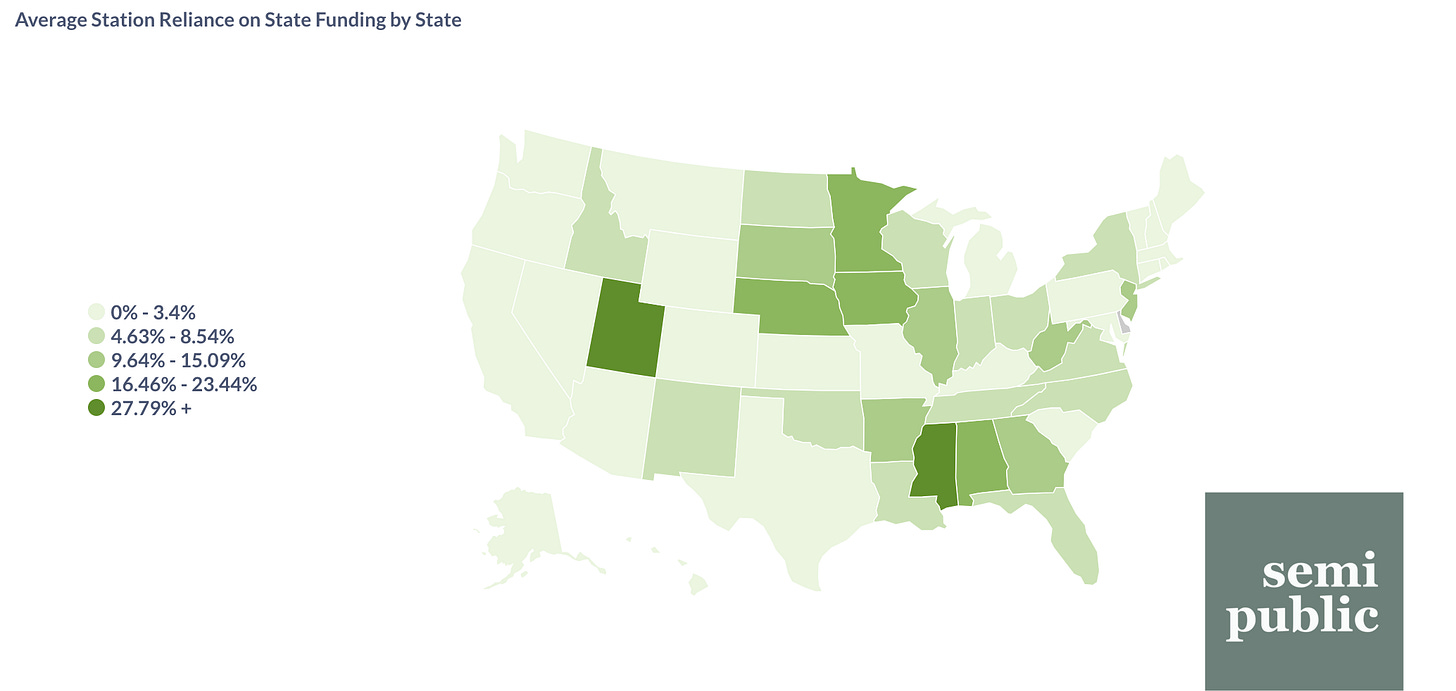
Public Media’s State Funding: An Overview
In fiscal year 2023, public media stations across the country relied on state funding for an average of about 6% of their total revenue. That’s less than half of public media’s overall reliance on federal funding, which was about 15%. Interestingly, average state reliance by stations doesn’t break down along the same state lines that average federal funding did.
In fact, when we separate out each state by its census-designated region, the picture is nearly reversed: Western states relied on state funding much less on average than they did federal funding, while the Midwest relied much more heavily on state funding.
I found it interesting that the South, on average, turned out to be the second-most reliant region: Obviously, Midwestern states fund their public media stations much more as a percentage of station revenue, but 7 of the 16 Southern states had an average station reliance on federal funding that was higher than the national average. Not only that, but the region, in my dataset, very nearly has the same amount of public media stations as the Midwest. Compare that to the 2011 study conducted by NPR, which found that stations in the South would be more vulnerable to federal funding cuts than stations in other regions. As I’ve discussed before, stations in that region must have heeded the warning, because in FY23, the South turned out to be less reliant on average than other regions - perhaps those stations managed to trade federal funding for state funding instead.
When looking at broadcast medium, it’s clear that public television stations are much, much more reliant on state funding, on average, than public radio stations are. In fact, public television is almost 3x more reliant than public radio, with state funding making up an average of just over 11% for the former, and 3% for the latter. The breakdown is nearly identical when dividing stations up by network affiliation.
Another interesting finding is that stations that are not affiliated with either NPR or PBS - mostly music stations - only had a slightly higher reliance on state funding on average than NPR-affiliated stations, or even all public radio stations. In my breakdown of average federal funding reliance, I found that these stations were more dependent on that funding than other stations. That doesn’t necessarily seem to be the case with state funding.
One finding that did not differ from my look at federal funding was average station reliance on state funding broken down by how the state voted in the 2024 Electoral College. As it turns out, public media stations in states that voted for Biden, on average, rely on state funding two points less than states that voted for Trump, with Mississippi (33%), Utah (28%), and Alabama (23%) leading the way.
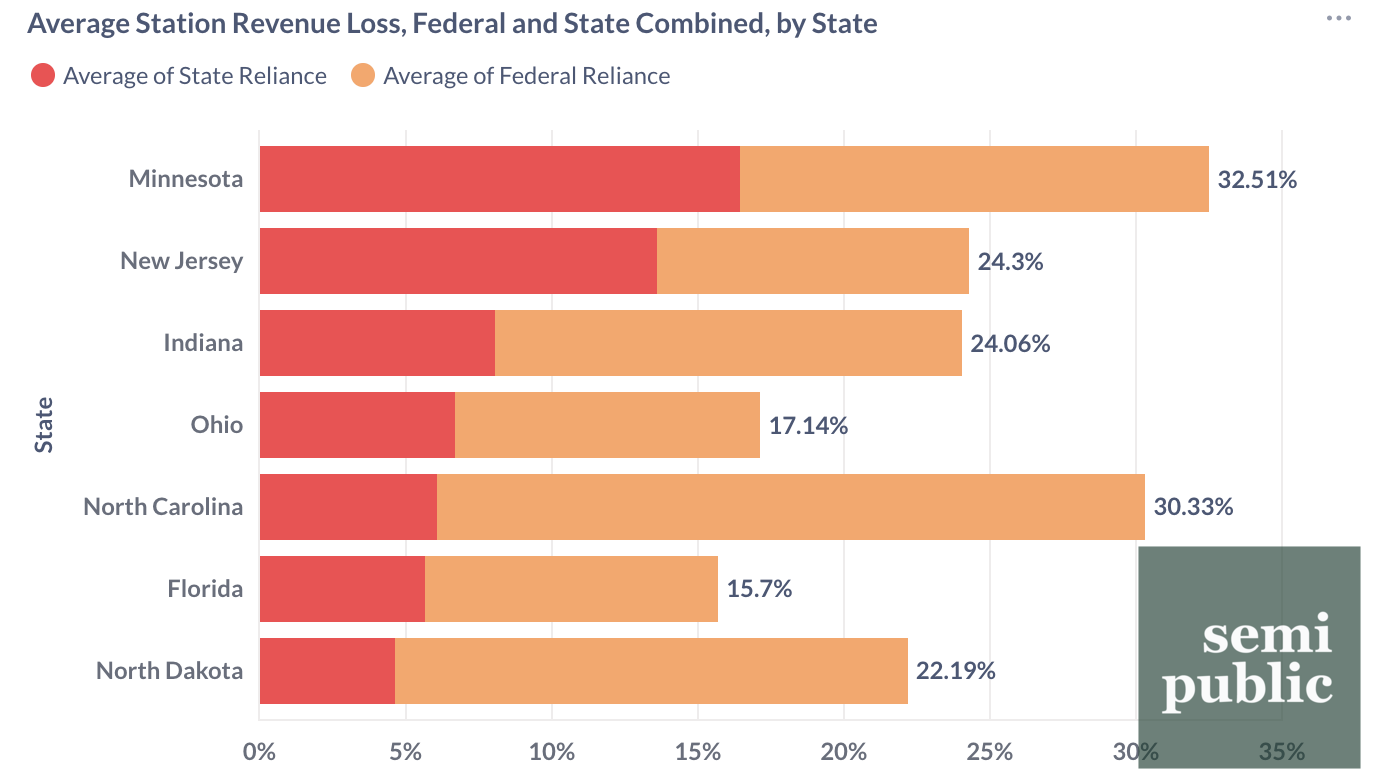
Which Stations are Most Affected?
Among the two states that have completely eliminated funding for public media, stations in Indiana have been hit the hardest, losing a combined average of 24% of their total revenue. Ohio stations, on the other hand, are losing an average of 17%.
Additionally, stations in Minnesota and North Carolina far and away have the highest average reliance on both federal and state funding, with the former having the highest state funding reliance of any of the affected states, and the latter having the highest reliance on federal funding. These two states have not completely cut public media spending, but an accounting of their total reliance on both that and federal funding shows just how vulnerable those stations are.
When broken down by broadcast medium, public television stations remained the clear leader. It’s evident that public television stations - not just in these states, but across the country - rely on state funding nearly as much as they did on federal funding, putting them at much greater risk.
Remember that public television stations are already facing a crisis: While several public radio stations crossed the 50% threshold for reliance on federal funding, public television stations as a whole depended more on that funding on average than their radio counterparts.
Indeed, when looking at all stations in the two states that completely cut public media’s funding, Indiana and Ohio, 7 of the 8 stations losing 30% or more of their total revenue are television stations.
Forever a Crossroads
There are certainly reasons why public media should continue to keep its head held high - engaged donors, the formation of a large philanthropic fund for stations - but it’s obvious that state funding cuts are making a bad situation worse. I stated earlier that this is an opportune time for state governments to cut back spending on public media because the federal government has already broken the ice, and I would expect to see more legislatures taking advantage of the timing over the next year or so.
Luckily, public media’s time or mourning has quickly morphed into. a time of action. In that spirit, here’s what I think will be key for at-risk stations to stay afloat while the industry reinvents itself:
Increasing your revenue diversity while decreasing your expense diversity.
The cuffs are off, and your next 2-3 years will probably be solely about surviving - there’s no better time to act on the previously-unimaginable. Form a podcasting/production studio for commercial clients, merge HR departments with a nearby station, hire a statewide grantwriting team.
It’s easier said than done, especially for rural stations, but there is no other choice but to innovate. And I’m excited to see what public media stations come up with.
As always, here’s an interactive dashboard of some of the metrics discussed in this newsletter. If you enjoyed this post, please consider supporting me with a paid subscription, or by buying me a coffee.



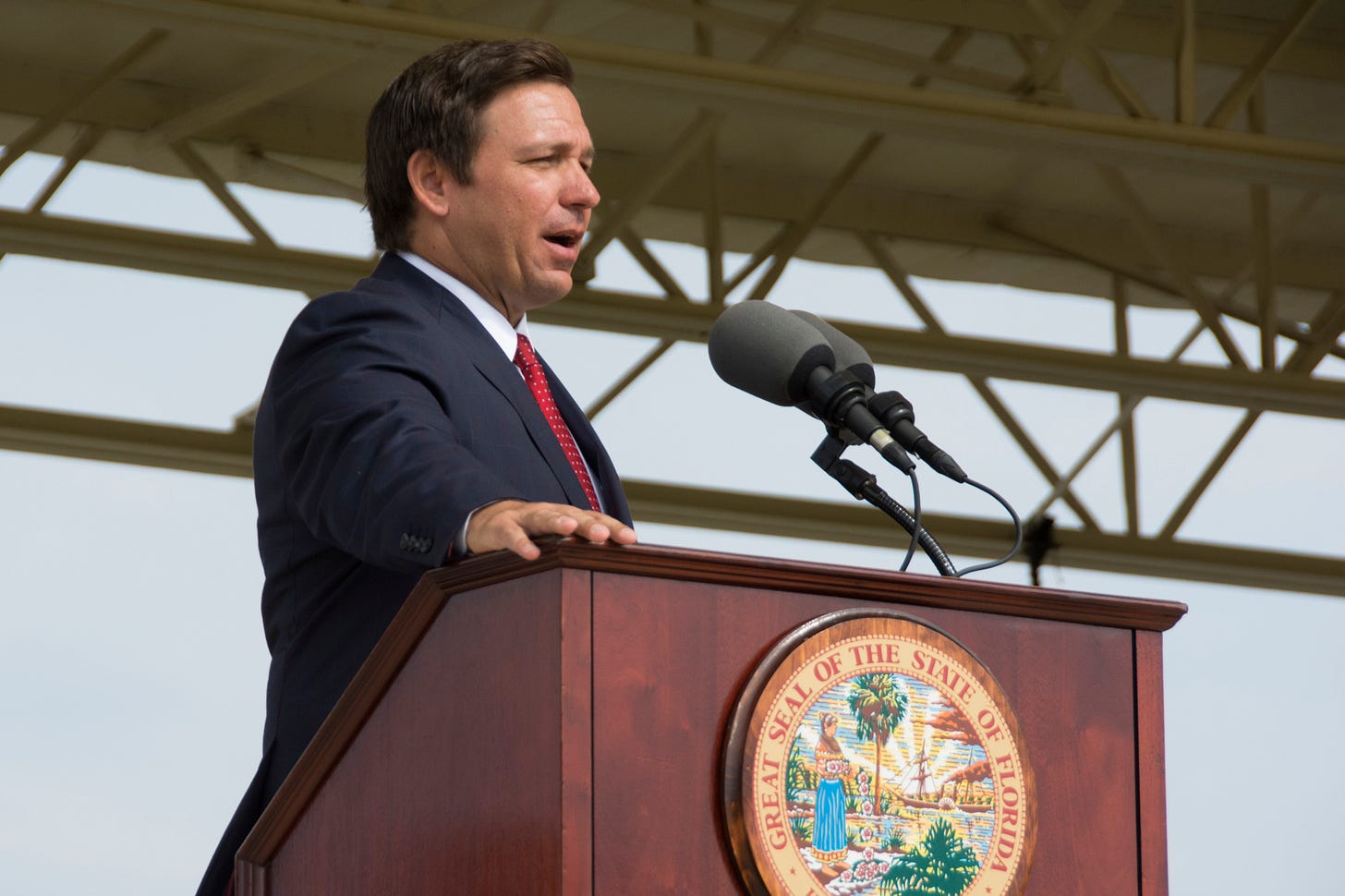

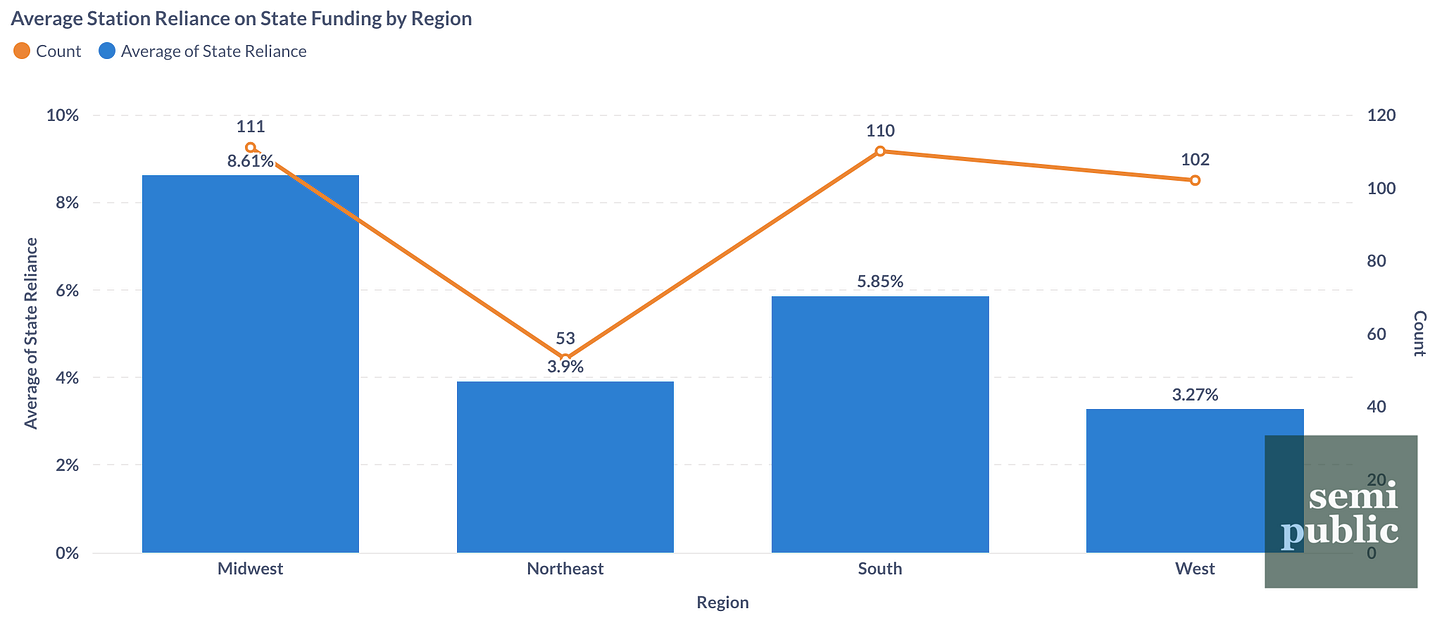

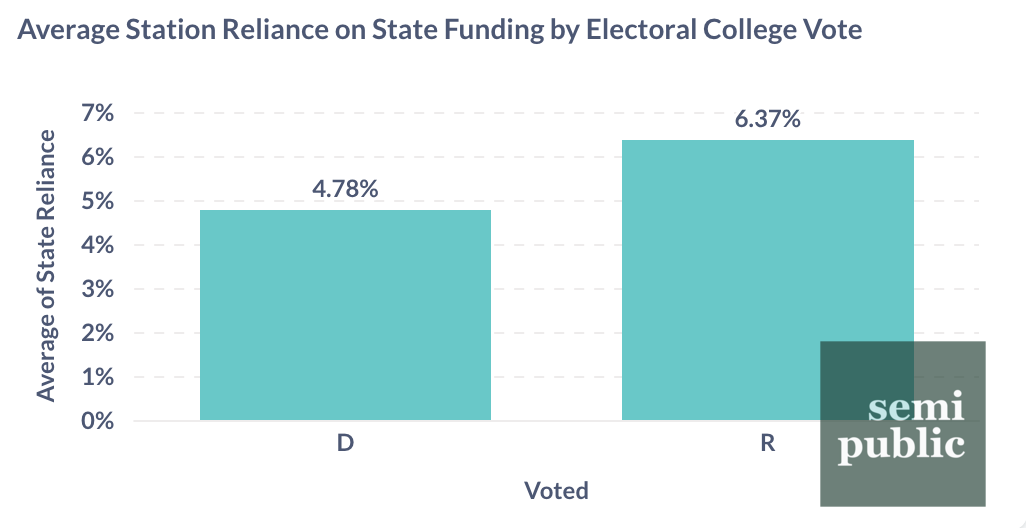
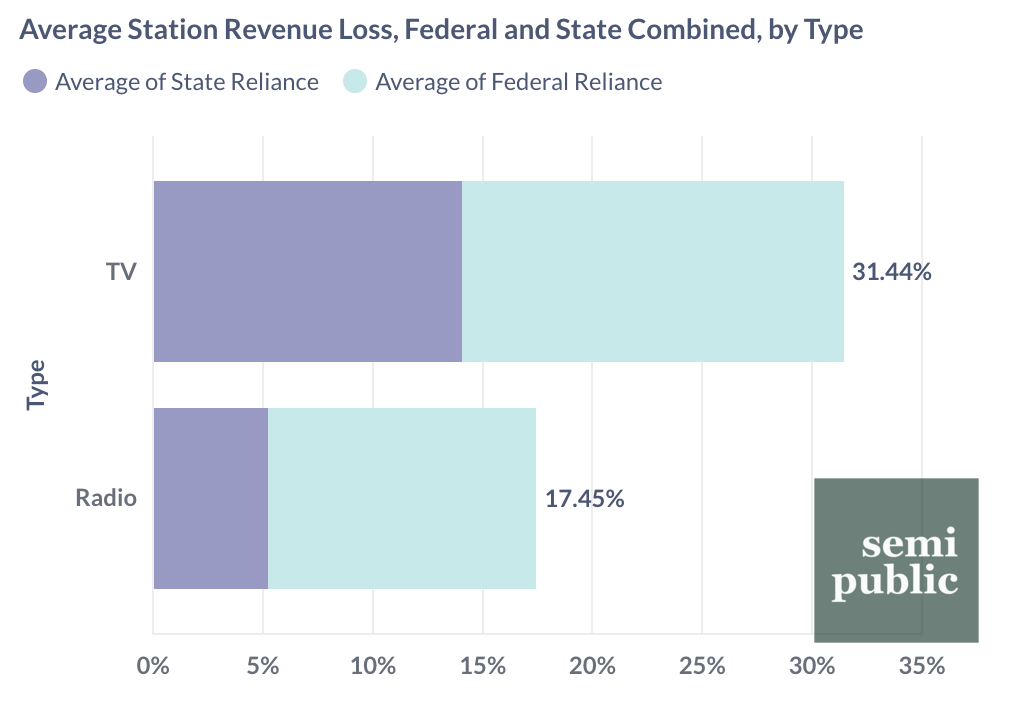
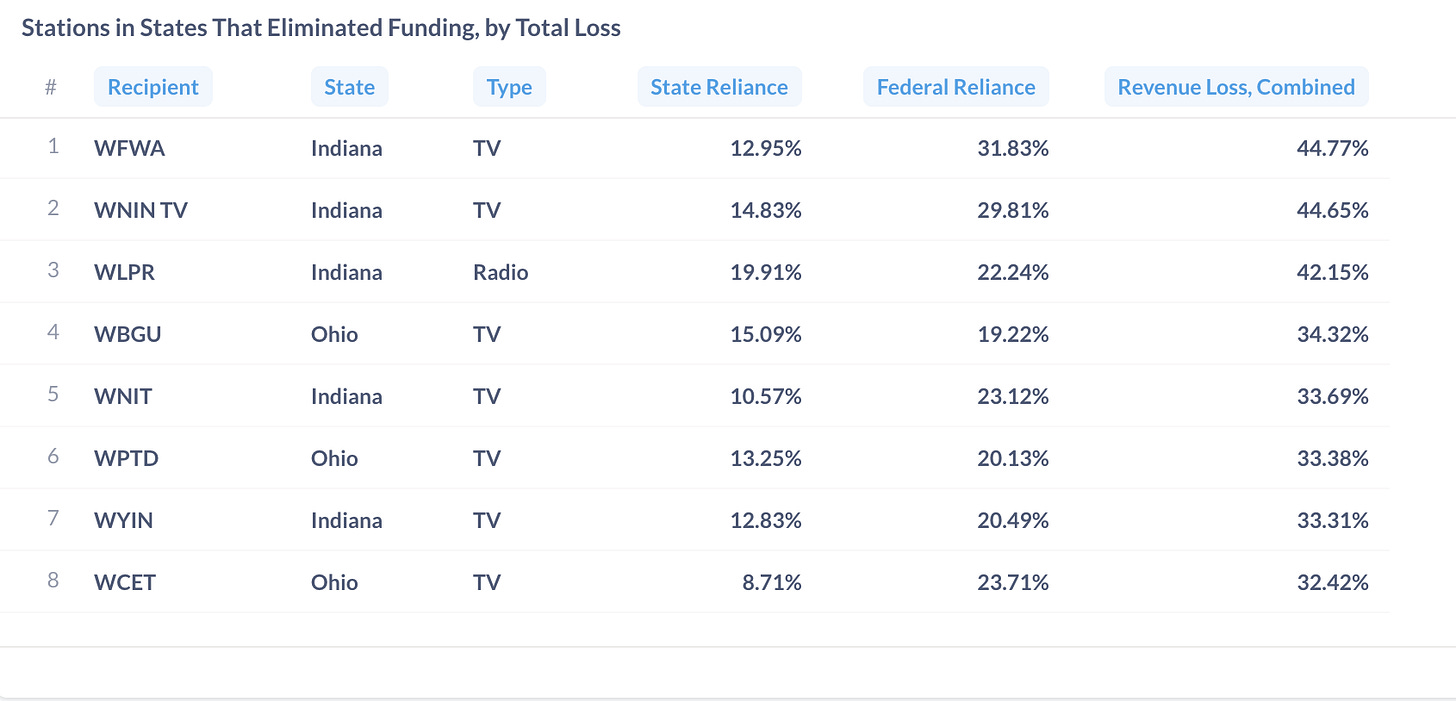
https://cpb.org/sites/default/files/Annual%20Revenue%20Report%202023.pdf
The CPB page 6 says 8.8% state funding goes to public media.
PS: college funding is mostly state taxes.